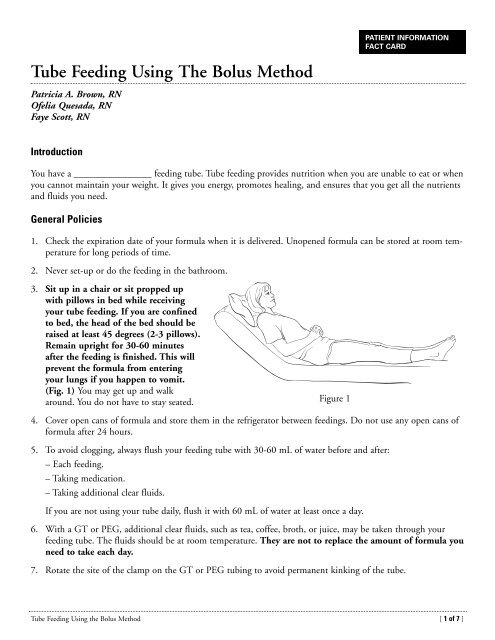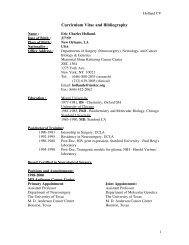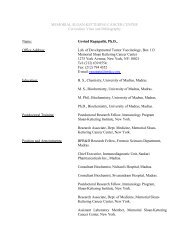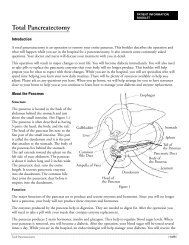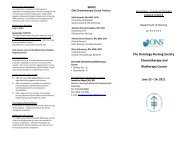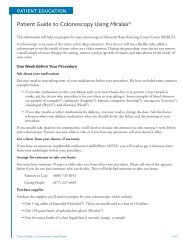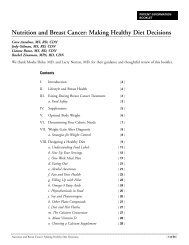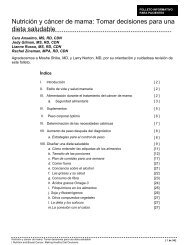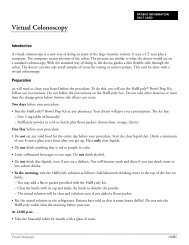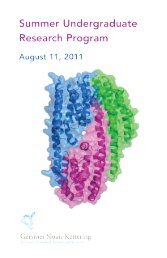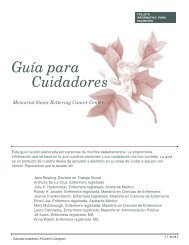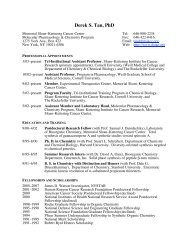Tube Feeding Using The Bolus Method - Memorial Sloan-Kettering ...
Tube Feeding Using The Bolus Method - Memorial Sloan-Kettering ...
Tube Feeding Using The Bolus Method - Memorial Sloan-Kettering ...
Create successful ePaper yourself
Turn your PDF publications into a flip-book with our unique Google optimized e-Paper software.
<strong>Tube</strong> <strong>Feeding</strong> <strong>Using</strong> <strong>The</strong> <strong>Bolus</strong> <strong>Method</strong><br />
Patricia A. Brown, RN<br />
Ofelia Quesada, RN<br />
Faye Scott, RN<br />
Introduction<br />
You have a ________________ feeding tube. <strong>Tube</strong> feeding provides nutrition when you are unable to eat or when<br />
you cannot maintain your weight. It gives you energy, promotes healing, and ensures that you get all the nutrients<br />
and fluids you need.<br />
General Policies<br />
1. Check the expiration date of your formula when it is delivered. Unopened formula can be stored at room temperature<br />
for long periods of time.<br />
2. Never set-up or do the feeding in the bathroom.<br />
3. Sit up in a chair or sit propped up<br />
with pillows in bed while receiving<br />
your tube feeding. If you are confined<br />
to bed, the head of the bed should be<br />
raised at least 45 degrees (2-3 pillows).<br />
Remain upright for 30-60 minutes<br />
after the feeding is finished. This will<br />
prevent the formula from entering<br />
your lungs if you happen to vomit.<br />
(Fig. 1) You may get up and walk<br />
around. You do not have to stay seated.<br />
Figure 1<br />
4. Cover open cans of formula and store them in the refrigerator between feedings. Do not use any open cans of<br />
formula after 24 hours.<br />
5. To avoid clogging, always flush your feeding tube with 30-60 mL of water before and after:<br />
– Each feeding.<br />
– Taking medication.<br />
– Taking additional clear fluids.<br />
If you are not using your tube daily, flush it with 60 mL of water at least once a day.<br />
6. With a GT or PEG, additional clear fluids, such as tea, coffee, broth, or juice, may be taken through your<br />
feeding tube. <strong>The</strong> fluids should be at room temperature. <strong>The</strong>y are not to replace the amount of formula you<br />
need to take each day.<br />
7. Rotate the site of the clamp on the GT or PEG tubing to avoid permanent kinking of the tube.<br />
PATIENT INFORMATION<br />
FACT CARD<br />
<strong>Tube</strong> <strong>Feeding</strong> <strong>Using</strong> the <strong>Bolus</strong> <strong>Method</strong> [ 1 of 7 ]
8. Wash all your equipment with warm water and a small amount of soap after each feeding. Rinse well and let<br />
the equipment dry. It is important that all the soap is rinsed away.<br />
<strong>Bolus</strong> <strong>Feeding</strong> Procedure<br />
1. Gather your supplies.<br />
Appropriate amount of formula<br />
Empty container<br />
Container of water<br />
Cup<br />
60-mL catheter tip or piston tip syringe<br />
PEG button adapter (if you have a PEG<br />
button)<br />
2. Wash your hands thoroughly with soap and<br />
water or an alcohol hand cleaner. Dry them<br />
with a paper towel.<br />
3. Open the plug at the end of your feeding<br />
tube. (Fig. 2a) (Insert the PEG button<br />
adapter if you have a PEG button.) (Fig.<br />
2b)<br />
4a. Draw 30-60 mL of water into the syringe.<br />
(Fig. 3) Unclamp the feeding tube. (Fig. 4)<br />
Insert the tip of the syringe into the end of<br />
the feeding tube or adapter and flush it with<br />
the water with the syringe. (Fig. 5) Reclamp<br />
the tube. Disconnect the syringe.<br />
2CUPS<br />
1 1 / 2<br />
1CUP<br />
1 / 2<br />
16 OZ 1 PINT<br />
12<br />
8<br />
4<br />
1 2 / 3<br />
1 1 / 2<br />
1CUP<br />
2 /3<br />
1 /2<br />
Figure 2a<br />
Figure 4<br />
Figure 2b<br />
Figure 3 Figure 5<br />
<strong>Tube</strong> <strong>Feeding</strong> <strong>Using</strong> the <strong>Bolus</strong> <strong>Method</strong> [ 2 of 7 ]
Pour the proper amount of formula into the<br />
empty container. Draw formula into the<br />
syringe and attach the tip of the syringe to<br />
the feeding tube or adapter. (Fig. 6 and Fig.<br />
7) Be sure the tip of the syringe is firmly<br />
inserted in the tube or adapter. Unclamp the<br />
feeding tube.<br />
Slowly push the plunger down. Clamp the<br />
feeding tube between each bolus to prevent<br />
16 OZ 1 PINT<br />
leakage. Refill the syringe with formula.<br />
1<br />
Repeat the procedure until the desired<br />
amount of formula is injected. If you feel full,<br />
wait 10-15 minutes before you continue the<br />
1CUP<br />
feeding.<br />
4b. Instead, you may:<br />
• Remove the plunger from the syringe.<br />
• Insert the tip into the feeding tube.<br />
• Hold the syringe upright and fill it first with 30 – 60 mL of water.<br />
• Unclamp the feeding tube.<br />
• Let the water drip in and refill with the formula when the level gets low.<br />
(Fig. 8)<br />
2 / 3<br />
1 1 12<br />
/ 2<br />
8<br />
4<br />
2 /3<br />
1 /2<br />
Figure 6<br />
5. At the end of the feeding, flush the tube with at least 30-60 mL of water (or<br />
more if necessary). Clamp the tube, remove the button adapter (if used), and<br />
cap the feeding tube.<br />
6. Repeat these steps with each feeding.<br />
7. Wash all your equipment with warm soapy water after each feeding. Rinse it<br />
well and let it dry. Be sure all soap is rinsed off.<br />
Repeat the entire procedure 3 4 5 times a day as tolerated. Not everyone<br />
can take the amount prescribed. If you cannot tolerate it, call your doctor,<br />
dietitian, or nurse.<br />
Taking Medicines<br />
You can take medicines that you normally take by mouth through your feeding tube. Talk to your doctor or<br />
pharmacist about your medicines to make sure this method can work for you. Some medicines have to be<br />
taken on an empty stomach; others must be taken with food. If you are taking Prevacid ® or Prilosec ® , ask your<br />
pharmacist, doctor, or nurse how to take these medicines through your feeding tube.<br />
Set up a medicine schedule. Keep it posted where it is readily available. Update it when anything changes. That<br />
will make it easy for all family members or caregivers to consult it, if necessary. Carry a copy with you on your visits<br />
to your doctor. Your doctor will want to review your medicines at each visit.<br />
<strong>The</strong> medicines must be in liquid or powder form to prevent the tube from being clogged.<br />
2CUPS<br />
1 1 / 2<br />
1CUP<br />
1 / 2<br />
Figure 7<br />
Figure 8<br />
• Many medicines come in a liquid form. Ask your doctor or pharmacist about liquid forms if you take pills,<br />
tablets, or capsules. Liquid medicines contain sorbitol as a base. Sorbitol can cause bloating, cramping, diarrhea,<br />
or all three if not taken as directed.<br />
<strong>Tube</strong> <strong>Feeding</strong> <strong>Using</strong> the <strong>Bolus</strong> <strong>Method</strong> [ 3 of 7 ]
• Medicines that come in a tablet form must be crushed to a fine powder using a mortar and pestle or a pill<br />
crusher. You can buy these at your local drugstore.<br />
• Medicines that come in the form of a capsule must be opened. This is so the powder inside can dissolve.<br />
Always flush the feeding tube before and after you take the medicine. This will prevent clogging.<br />
<strong>The</strong> following technique applies when giving most drugs.<br />
1. Gather all your supplies:<br />
A small cup or glass<br />
A small syringe or medicine cup<br />
A 60-mL catheter tip or piston tip syringe<br />
Medication in liquid or powder form<br />
Mortar and pestle or a pill crusher<br />
Water<br />
Spoon<br />
Adapter if you have a button<br />
2. Wash your hands thoroughly with soap and water or an alcohol hand cleaner. Dry them with a paper towel.<br />
3. Flush your tube with 30 to 60 mL of water.<br />
4. Do not mix different medications together.<br />
5a. If your medicine is in liquid form:<br />
– Pour the medication into a small medicine cup or draw up the exact amount using a small syringe. Unless<br />
otherwise instructed, administer each liquid medication separately.<br />
– Add 30 mL of water to the prescribed amount of medicine. Draw up solution using the piston syringe.<br />
– Go to step 6.<br />
5b. If your medication is in pill form:<br />
– Crush the prescribed amount of each medicine. Use a mortar and pestle or pill crusher. Crush each medicine<br />
separately to a fine powder. Add 30 mL (one ounce) of warm water to each. Mix it well until the medicine<br />
dissolves.<br />
– Draw the prepared medication into the 60 mL syringe.<br />
– Go to step 6.<br />
5c. If the medicine is a capsule:<br />
– Open the prescribed number of capsule(s).<br />
– Mix the powder in the capsule with 30 mL (one ounce) of warm water.<br />
– Draw the prepared medication into the 60 mL syringe.<br />
– Go to step 6.<br />
6. Attach the syringe to the feeding tube or button adapter, if used. Unclamp the tube and gently push in your<br />
medicine. Reclamp the tube.<br />
7. Attach the syringe filled with 30-60 mL of water to the feeding tube. Unclamp the tube and flush it thoroughly.<br />
Reclamp it before removing the syringe. Repeat the flushing if the water moves too slowly through the tube.<br />
8. To avoid leakage, always reclamp your tube before removing the syringe.<br />
<strong>Tube</strong> <strong>Feeding</strong> <strong>Using</strong> the <strong>Bolus</strong> <strong>Method</strong> [ 4 of 7 ]
9. Close the plug or reattach the cap at the end of your feeding tube. (If used, remove the PEG button adapter.)<br />
10. After taking the medicine(s), pull the syringe apart and wash all equipment with warm, soapy water. Rinse all<br />
equipment well.<br />
If you are taking a large number of medicines, ask your pharmacist if you can take them together.<br />
Special Points<br />
• Your bowel movements may change somewhat while you are on tube feedings. <strong>The</strong>y may also change if you are<br />
on pain medicine. To avoid constipation, take a stool softener (e.g., Colace ® ), or a mild laxative (Metamucil ® ,<br />
Senokot ® ) as directed.<br />
If you develop bloating, nausea, stomach cramps, and/or diarrhea (three or more watery bowel movements a day):<br />
1. For your next feeding, replace the formula with an equal amount of clear liquid. Clear liquids are anything you<br />
can see through, such as ginger ale, tea, or broth.<br />
For example:<br />
If you take Take this instead<br />
• 250 mL of formula with 250 mL of water • 250 mL of broth or other clear liquid with the water<br />
2. For the following feeding, take half as much formula as normal with the full amount of water. Allow it to drip<br />
slowly.<br />
3. When your symptoms disappear, take the full amount of formula and water.<br />
4. If you have the above symptoms for more than 24 hours and/or you develop vomiting, call your doctor or<br />
nurse.<br />
If you develop constipation:<br />
1. Take additional fluids by mouth (if able) or through the feeding tube.<br />
– Take one cup of fluid three times a day between your feedings.<br />
– You may take water or four ounces of prune juice daily to relieve constipation.<br />
– Always flush the tube using the syringe with 30-60 mL of water as needed after taking any juice.<br />
2. Call your doctor, dietitian, or nurse if :<br />
– Your stool remains hard and dry,<br />
– You do not have a bowel movement after two days, or<br />
– You develop nausea or vomiting.<br />
To monitor fluid balance:<br />
Weigh yourself two times a week at the same time of day and in the same type of clothing.<br />
Call your doctor, dietitian, or nurse if you:<br />
• Gain more than five pounds per week.<br />
• Lose more than two pounds per week.<br />
• Develop swelling of your feet, legs, hands, or face.<br />
• Develop excessive thirst or dizziness.<br />
<strong>Tube</strong> <strong>Feeding</strong> <strong>Using</strong> the <strong>Bolus</strong> <strong>Method</strong> [ 5 of 7 ]
Keep a diary to check your progress<br />
1. Record your weight twice weekly.<br />
2. Keep track of any food or liquid taken by mouth in addition to the tube feeding. This will tell you your total<br />
nutritional intake.<br />
3. Note any swelling of your face, hands, or feet.<br />
4. Note any changes in stool or urine color, consistency, frequency, or volume.<br />
5. Note any abdominal discomfort, nausea, vomiting, or other problem that may relate to your feeding.<br />
A daily record will help if you have medical problems or questions. It will also help you document what has been<br />
going on at home if you need to come to the hospital. If you are admitted and tube feedings are to continue, your<br />
nurse will contact the unit dietitian so that there is no change in your feeding schedule. During your first week at<br />
home, a nurse or dietitian will call to check your progress with the feeding tube.<br />
<strong>Tube</strong> <strong>Feeding</strong> Schedules<br />
Suggested times Amount of formula<br />
8 a.m. ______ can<br />
12 noon ______ can<br />
4 p.m. ______ can<br />
8 p.m. ______ can<br />
<strong>The</strong>se are suggested times only. You can choose the hours of your feeding, as long as you reach your daily nutritional<br />
goal.<br />
Depending on your fluid needs, you may need to drink extra fluids or add water to your formula. Your doctor,<br />
dietitian, or nurse will determine this.<br />
Nutritional Goal<br />
Formula_______________________________________________<br />
cans per day ______________total kcal ______________________<br />
Total fluid volume _________additional water to take ___________<br />
Supplies<br />
<strong>The</strong> case manager will check with your insurance company about your coverage. If you have appropriate insurance<br />
coverage, you will be referred to a home care provider. <strong>The</strong>y will supply you with formula and equipment as<br />
ordered. It usually arrives the next day. If you do not have insurance coverage, you can buy the formula at a local<br />
drug store or grocery or use other liquid food.<br />
If you are no longer on tube feedings, leftover supplies can be donated. Check with your local visiting nurse service<br />
(VNS), hospice program, nursing home, food bank, or church to see if they can use them for other patients. <strong>The</strong> Oley<br />
Foundation (800-776-OLEY, www.oley.org) can be contacted for donation to other patients at home.<br />
<strong>Tube</strong> <strong>Feeding</strong> <strong>Using</strong> the <strong>Bolus</strong> <strong>Method</strong> [ 6 of 7 ]
Call Your Doctor or Nurse If You:<br />
• See any of the following at your insertion site:<br />
– Bleeding that soaks a small gauze pad<br />
– Pus/Drainage with a foul smell<br />
– Redness<br />
– Swelling<br />
– Increased pain not relieved by medication<br />
• Have abnormal abdominal swelling.<br />
• Have nausea or vomiting.<br />
• Have diarrhea.<br />
• Have constipation.<br />
• Have a fever of 101° F (38.3° C), with or without chills.<br />
Telephone Numbers<br />
Doctor________________________________________________<br />
Phone ________________________________________________<br />
Home care provider______________________________________<br />
Phone ________________________________________________<br />
Home care contact person _________________________________<br />
Follow-up appointment:<br />
Date____________________Time _________________________<br />
Monday through Friday from 9 a.m. to 5 p.m., call the Nutrition Service office at 212-639-6985 and ask for the<br />
outpatient nurse.<br />
If you have any problems after 5 p.m. on weekdays and on weekends, call the page operator at (212) 639-7900<br />
and ask for the GI fellow on call.<br />
Illustrations by Medical Graphics & Photography<br />
©2006 <strong>Memorial</strong> <strong>Sloan</strong>-<strong>Kettering</strong> Cancer Center<br />
1275 York Avenue, New York, New York 10065<br />
Revised 2009<br />
<strong>Tube</strong> <strong>Feeding</strong> <strong>Using</strong> the <strong>Bolus</strong> <strong>Method</strong> [ 7 of 7 ]


